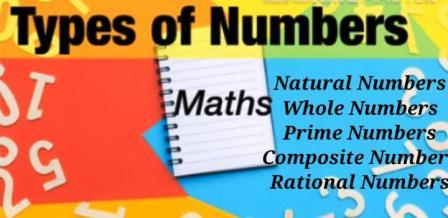Types of Numbers – Natural, Whole, Prime Number etc.

Question on Types of Numbers is generally asked in most of the competitive exams like SSC CGL, CTET, TET etc. In this post you will learn Number Types like Natural Numbers, Whole Numbers, Prime Number, Composite Number etc.
Number Types
Natural Numbers
Numbers 1, 2, 3, 4, 5, 6,……. which are used to count the objects are called natural numbers.
Note: Zero (0) is not a natural number.
Whole Numbers
All natural numbers (1,2,3,4….) together with zero (0) are called whole numbers.
Integers
All natural numbers (1,2,3,4,…..) together with their negatives (-1,-2,-3,…) and with zero (0) are called integers.
1,2,3,4,5… are called positive integers and -1,-2,-3…. are called negative integers.
Note: Zero (0) is neither positive nor negative integer.
30 Important EVS Questions for TET in Hindi
Prime Numbers
A number greater than one (1) which can not be divided by any number except one (1) and itself is call a prime number.
e.g. 2, 3, 5, 7, 11 etc.
Composite Numbers
Numbers greater than one (1) which are not prime numbers are called composite numbers.
e.g. 4, 6, 8, 9, 10 etc.
Even Numbers
The numbers which are divisible by 2 are called even numbers.
e.g. 2, 4, 6, 8, 10 etc.
Note: 2 is the only prime number which is even number also.
Odd Numbers
The numbers which are not divisible by 2 are called odd numbers.
e.g. 1, 3, 5, 7, 9, 11 etc.
Rational Numbers
A rational number can be represented in form of “p/q”, where p and q are integers and q is not equal to zero (0).
e.g. 2,3, 1/2, 2/3, 5 etc.
Note: All integers and fractions are rational numbers.
Famous National Parks of India and their Rare Species
Irrational Numbers
An irrational number can not be represented in the form of “p/q”, where p and q are integers and q is not equal to zero (0).
e.g. √2, √3 which always give an approximate value instead of absolute fraction or decimal number.
Successor Numbers
For any natural number the immediate next natural number is called successor number. In any natural number if we add one (1), we will get successor number of that number.
e.g. Two (2) is the successor number of one (1). Five (5) is the successor number of four (4).
Predecessor Numbers
For any natural number the immediate last natural number is called predecessor number. For any natural number if we subtract one (1), we will get predecessor number of that number.
e.g. Two (2) is the predecessor number of three (3). Five (5) is the predecessor number of six (6).
Decimal Numbers
A number containing a decimal point (.) is called a decimal number.
e.g. 1.2, 2.3, 1.1 etc.
Micro Teaching – for CTET and Other TETs Preparation
You may use ‘comment section’ below for your valuable comments/feedback.
